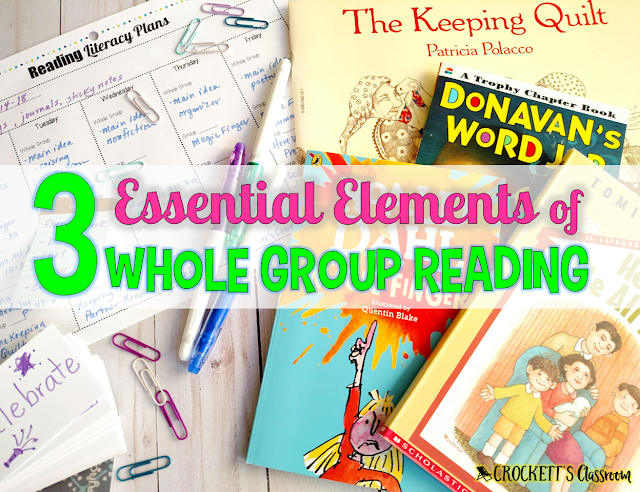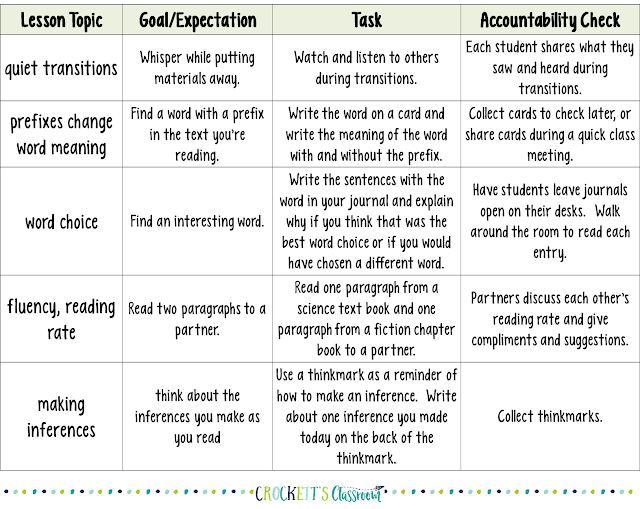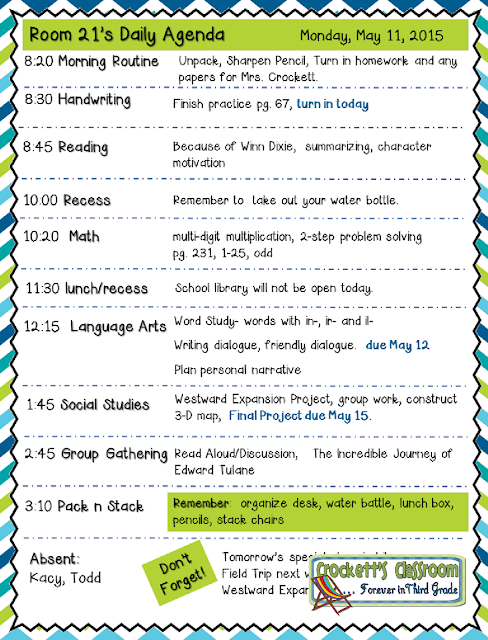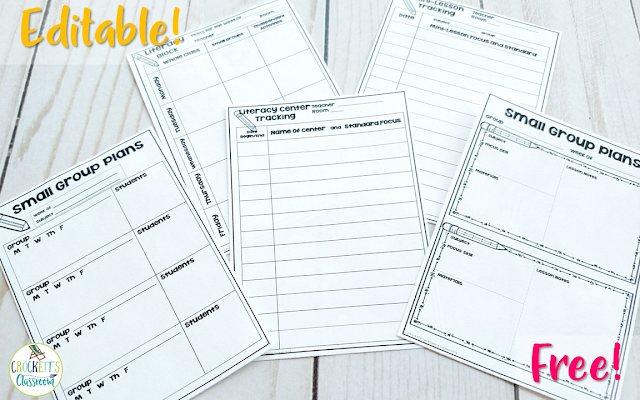When I first started teaching (back in the Stone Age J ), my reading instruction time had 2 parts. Most of the time was spent in whole-class skill lessons. Then, I'd listen to my high, middle and low groups read aloud. I've learned a lot about teaching reading since then! Also, the pendulum of reading instruction has swung from teaching totally whole-class to total individualized reading instruction. Like most things, somewhere in the middle is best. There is a need for both whole-class, small group, and individualized reading instruction. That’s why a reading block needs whole-class instruction, guided small group lessons, and individual activities. (You can read this blog post to learn about the basics of a literacy block.)
During whole-class instruction, there are three elements I think are essential; focused lessons, using a common text and setting goals/expectations. These elements form the framework for my whole-class lessons. Typically, I decide on the skill or strategy I want to teach in the focused lesson, choose the piece of text, and then set goals or expectations for the rest of the literacy block.
Focused Lesson
The focused lesson is the main instruction time of the whole-class lesson. It can focus on reading strategies, skills, vocabulary, phonics, word study, reading behaviors or expectations, fluency, genre characteristics, etc.
You might have a district-mandated curriculum or adopted reading textbook that outlines all of your lessons. If that’s the case, then teach those lessons. But, if you have more flexibility, deciding what to teach is the first step. I begin by mapping out the standards for the year. Filling out a Year-at-a-Glance planning page for the reading standards I need to teach helps keep me on track. (See the bottom of this post for resources that will help with the planning. ) Then I move on to looking at the student data that's been gathered through formal and informal assessments, checklists, and observations. Using the Year-at-a-Glance plan and the student data you’ll want to teach focused lessons that address the needs of the majority of your students.
What types of focused lessons should I teach?
Most focused lessons can be put into three categories; expectations, strategies and skills and literary analysis. I’ve put together a very short list of ideas. You can use this as a starting point and build your focused lesson list from here. You’ll soon find that this list could be endless.
ØThe lessons on expectations focus on student behaviors and responsibilities. These lessons are usually covered during the first few weeks of school, but refresher lessons will probably be needed throughout the year. Here are a few topics for these focused lessons:
•getting out and putting away materials
•respecting the learning of others
•work quality
•how to write a journal response
•choosing “just right” books
•giving a book talk or review
•how the class library is organized
•caring for materials
•transiting from small groups to centers
ØStrategies and skills focused lessons focus on the standards you need to teach. Here are a few of the broad areas you would cover in this category: (Your lessons will probably be much more specific.)
•Phonics, example- words with the long a sound, ai, ay, a_e, eigh
•Punctuation, example- how a comma placement affects the meaning of a sentence.
•Word Study, example- affixes change the meaning of words, treat, mistreat, treatable
•Comprehension, summarizing, using a SWBT organizer
•Text structures, example- how to use a glossary, index, and table of contents
•Fluency, example- using voice tone to express a character’s emotion
ØThe third category of focused lessons is literary analysis. These lessons focus on different genres and understanding the techniques authors use when writing different genres. Here are a few examples of focused lesson topics:
•Story elements, example- how the setting affects the plot
•Text organization, example- problem/solution organization of fiction stories
•Word choice, example- how words set the mood of the story
•Genre studies, example- characteristics of a specific genre
•Responding to literature, example- how a character made you feel
Common Text
When teaching your whole class, you need to have the same text for all your students. There are a few exceptions, which I’ll explain later. This text can be a textbook or literature study book they each have, individual copies of an article, poem or workbook, text shared by two students, text projected onto your whiteboard, or a big book that all students can see. I also include a read-aloud book or text as a common text.
Why?
Having this common text gives all students the chance to interact with the lesson. They’re all seeing the same text and hearing the same discussion. Are they all mastering the skills/strategies at the same time? Of course not, that’s the purpose of small groups and independent activities. Whole-class instruction is when I introduce skills and strategies, mastery will come after students have more opportunities to use them in their independent reading tasks.
Where?
In most classrooms, there are really only two places you can meet with your whole-class; on the floor in a meeting area, or having kids stay at their desks or tables. The location will change depending on several things.
•What text is being used? If you’re displaying the text on the whiteboard and that is closer to the student desks, then you’ll meet there. If the text is a big book or a read aloud, you’ll probably meet on the floor in your meeting area. If the students are in pairs to share a text, that might work in the meeting area or at their desks.
•What will the kids be doing? If they will be doing much writing during the lesson, then I usually like to keep them at their desks. Although, clipboards and composition book journals can be written in when they’re seated on the floor.
•How is their behavior? I’d like to say that all of my classes have been able to show model behavior when I’m teaching, but that would be a lie. There have been days, seasons and sometimes whole years when my group of kids just can’t focus when we’re gathered in our meeting area on the floor. No matter how much time we spend modeling behavior and setting expectations, some groups of kids just can’t handle this less structured meeting area for very long. So, we sometimes spend more time at our desks than I’d like.
What?
What text can you use? This question is easy. . . anything! The type of text, of course, will depend on the objective of the lesson. Don’t limit yourself to the district mandated reading text. Although they have great stories, articles, and poems, I think kids need to experience as many different genres of text as possible. Here’s a short list of possibilities:
-literature or novel studies
-poetry
-newspapers
-content area textbooks (science, social studies, and even math textbooks)
-copies of travel brochures
-menus
-online articles
-fairy tales, folktales, myths, legends
-picture books
-plays
-how-to instructions
-owner’s manualsThese genre stickers will help you keep your class library and resources super organized. They're editable, so you can type in the specific genres you need. Click on the image to download your free set.
Earlier I stated there is an exception to students each having a copy of the text being used in the lesson. This might happen if you’re using a specific type of text but have different copies. Examples: travel brochures, how-to instructions, menus. Even though students may have different copies, each one will have the same features you want to discuss in your lesson.
Setting Goals and Expectations
My whole group time always ends with a class goal or expectation. I want my students to take something from the lesson and apply it right away. I send the kids off by assigning a short task that relates to the goal/expectation. To keep the kids accountable, I check on these goals or expectations at the end of the reading block. This accountability check will vary, depending on the task I’ve assigned. The accountability check should match the task. If the task is an action or behavior, then the accountability check can be a partner share or group discussion. If the task is written then the accountability check can be reading the journal entry or note card. These tasks and accountability checks are meant to be simple and quick. The kids will have other reading tasks to accomplish during the literacy block so I don’t want to add too much to their workload.
One of my favorite ways to check on students is with thinkmarks. These are bookmarks with a reminder or tips about the skill or strategy I want them to implement. They keep the thinkmark with them as they read and then write a response either on the back of the thinkmark or in their response journal.
To give thinkmarks a try in your classroom,
you can download this little freebie!
Here’s a chart with example focused lesson topics, goals, the assigned task, and accountability check.
This is a very, very short list of ideas. Hopefully, it shows the variety of tasks and accountability checks. The point is for kids to immediately practice. or try out, the focus of the focused lesson.
Helpful Resources:
The Ultimate Literacy Block (Editable) Planner is free! Click on the image to become one of my email friends and I'll send it to you right away!
Planning is a whole lot easier with this planner. There are so many pages that will help you keep your teaching life totally organized! Pages include calendars, monthly planning, weekly planning, small group planning, record keeping and so much more. Click on the image to preview the planner in my TpT store.
Thinkmarks are amazing! You can use them in so many situations. They give the student a little tip or reminder and help them focus on a recently presented strategy. Accountability goes way up when readers use thinkmarks.
Helpful Resources:
The Ultimate Literacy Block (Editable) Planner is free! Click on the image to become one of my email friends and I'll send it to you right away!
Planning is a whole lot easier with this planner. There are so many pages that will help you keep your teaching life totally organized! Pages include calendars, monthly planning, weekly planning, small group planning, record keeping and so much more. Click on the image to preview the planner in my TpT store.
Thinkmarks are amazing! You can use them in so many situations. They give the student a little tip or reminder and help them focus on a recently presented strategy. Accountability goes way up when readers use thinkmarks.




























